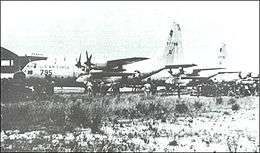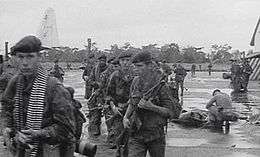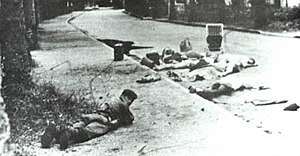Operation Dragon Rouge
Operation Dragon Rouge was a hostage rescue operation in the Democratic Republic of the Congo conducted by Belgium and the United States in 1964. The operation was led by the Belgian Paracommando Regiment to rescue hostages held by Simba rebels in the town of Stanleyville.
Background
By 1964, the Léopoldville government, supported by Western powers, was gaining a foothold in its fight to suppress the communist-backed Simba rebellion. Fearing an inevitable defeat, the rebels resorted to taking hostages of the local white population in areas under their control. On 28 October the Simba rebels arrested all Belgians and Americans in Stanleyville.[3] Several hundred hostages were taken to Stanleyville and placed under guard in the Victoria Hotel.
The Léopoldville government turned to Belgium and the United States for help. In response, the Belgian army sent a task force to Léopoldville, airlifted by the U.S. 322nd Air Division. Washington and Brussels worked jointly on a rescue plan. Several ideas were considered and discarded, and all attempts at negotiating with the Simbas had failed.
Operation
The Belgian task force was led by Colonel Charles Laurent.[4] On the early morning of 24 November 1964, five American C-130 Hercules planes dropped 320 Belgian paratroopers of the Paracommando Regiment onto the airfield at Stanleyville.[1] Once the paratroopers had secured the airfield and cleared the runway they made their way to the Victoria Hotel, prevented Simbas from killing most of the 60 hostages, and evacuated them via the airfield.
At 7:00 hrs, the hostages at Residence Victoria were rounded up by the Simba guards and ordered into the street. Around 50 of them had barricaded themselves in their rooms, after having heard the order on Radio Stanleyville at 6:30 to kill all foreigners, but most obediently moved into the street, as they were heading for the airfield. After a short march, when the Simba rebels got word that the airport of Stanleyville was now under Belgian control, the hostages were ordered to sit down in the street. After a few minutes, when heavy firing was heard nearby, some of the Simbas opened fire on the seated Belgians and Americans. The Paracommandos intervened and stabilized the situation by killing and/or driving away the Simbas; of the 250 hostages gathered by the rebels, 18 were already dead, and 40 were heavily wounded.[5]
Dr. Paul Carlson, an American medical missionary, was among those killed during the raid.[6] Around 1,600 foreign nationals and 150 Congolese civilians were evacuated.[7][8] In addition to the direct victims during the raid, several others were killed as a reaction to the arrival of the Belgian troops. Among these victims were many Missionaries, such as the Dox brothers.[9] By mid-December, about one month after Operation Dragon Rouge, a total of 185 foreign hostages left behind in various Simba controlled areas of the Congo, along with a few thousand Congolese civilians, had been executed by the Simba rebels. [10]
 Aircraft at Kamina airfield prior to Stanleyville flight |
 One of the hostages being evacuated by plane |
 Belgian paratroopers on Stanleyville airfield after the operation |
Aftermath
The operation coincided with the arrival of Armée nationale congolaise (ANC) and other foreign mercenary units—which likely included the hastily-formed 5th Mechanised Brigade and Mike Hoare's 5 Commando ANC—at Stanleyville which was quickly captured. Because of growing international pressure, Belgium and the U.S. decided to abandon plans for follow-on operations in Bunia and Watsa, a final rescue operation, Operation Dragon Noir, was carried out in Paulis on 26 November.[11] It took the central government until the end of the year to completely put down the remaining areas of the Simba rebellion.
Despite the success of the raid, Moise Tshombe's prestige was damaged by the joint Belgian–U.S. operation which saw white mercenaries and Western forces intervene once again in the Congo. In particular, Tshombe had lost the support of President Joseph Kasa-Vubu and Chief of the Army Joseph-Desiré Mobutu and was dismissed from his post as prime minister in October 1965.
References
- Odom 1988, p. 51.
- Abbott (2014), p. 18.
- Odom 1988, p. 40.
- Odom 1988, p. 46.
- Odom 1988, p. 94.
- Odom 1988, p. 102.
- Odom 1988, p. 180.
- Wagoner 1980, p. 182.
- Lamberigts, Mathijs; de Caluwe, Mark; Milh, Anton (2016). Predikbroeders in woord en daad : Dominicanen in Vlaanderen in de twintigste eeuw (first ed.). Halewijn. p. 98. ISBN 978-90-8528-393-5.
- Wagoner 1980, p. 198.
- Odom 1988, p. 122.
Bibliography
- Closset, A. (1995). Les Compagnons de l'Ommegang (in French). Avin-en-Hesbaye: Aronde. OCLC 123907589.CS1 maint: ref=harv (link)
- Ewing, J. R. (1965). "Congo Rescue" (PDF). The Airman. Vol. IX. No. 11. Washington, D.C.: GPO. pp. 10–13. ISSN 0002-2756.CS1 maint: ref=harv (link)
- Hoyt, M. P. E. (2000). Captive in the Congo: a Consul's Return to the Heart of Darkness. Annapolis: Naval Institute Press. ISBN 9781557503237.CS1 maint: ref=harv (link)
- Nothomb, P. (1993). Dans Stanleyville: Journal d'une Prise d'Otage (in French). Louvain-la-Neuve: Duculot. OCLC 716112136.CS1 maint: ref=harv (link)
- Odom, T. P. (1988). Dragon Operations: Hostage Rescues in the Congo. Leavenworth papers,0195-3451 ;no. 14. Fort Leavenworth: CSI Press. ISBN 9780160016950. OCLC 58396475.CS1 maint: ref=harv (link)
- Reed, D. E. (1965). One Hundred and Eleven Days in Stanleyville. New York: Harper & Row. OCLC 860117853.CS1 maint: ref=harv (link)
- Vandewalle, F. (1970). Odyssée et Reconquête de Stanleyville (in French). Brussels: Le Livre Africain. OCLC 586066343.CS1 maint: ref=harv (link)
- Verhaegen, B. (1967). "Les rébellions populaires au Congo en 1964". Cah. Études Afr. (in French). 7 (26): 345–59. doi:10.3406/cea.1967.3100.CS1 maint: ref=harv (link)
- Villafana, F. R. (2011). Cold War in the Congo: The Confrontation of Cuban Military Forces. Piscataway: Transaction. ISBN 9781412815222.CS1 maint: ref=harv (link)
- Wagoner, F. E. (1980). Dragon Rouge: The Rescue of Hostages in the Congo. Fort Belvoir: DTIC. OCLC 1017224836.CS1 maint: ref=harv (link)
External links

- Il y a 50 ans, à Stanleyville – La Libre Belgique, 3 August 2014 (in French)
